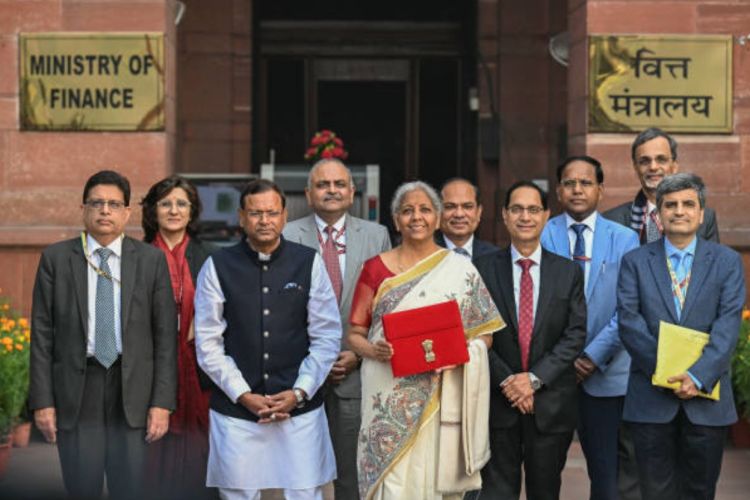
The Union Budget 2025-26 came at a time when the Indian economy is facing mounting challenges. The rupee continues to depreciate, foreign institutional investors have been persistently selling off since October 2024, and the stock market remains in a prolonged downturn. Adding to these concerns, India’s GDP growth has declined from 6.7% in the first quarter of FY25 to 5.4% in the second quarter, reflecting slowing economic momentum.
In this backdrop, the budget was seen as a crucial policy instrument to restore investor confidence, stabilise macroeconomic fundamentals, and provide much-needed relief to businesses and households.
READ | Budget 2025-26 places bet on youth, global competitiveness
Tax relief will offer limited demand boost
The tax relief to incomes up to Rs 12 lakh has grabbed the headlines. This move puts more money in people’s hands, stimulating spending and boosting overall demand in the economy. However, the reality is that this relief may be akin to offering a tissue to someone drowning. With India’s population of approximately 1.42 billion, only 8.09 crore income tax returns were filed in the fiscal year 2023-24, accounting for just 5-6% of the total population. This suggests that a significant portion of the population does not benefit from the tax relief, limiting its potential impact on the broader economy.
Historically, an individual was required to earn 3.5 times the national per capita income to become liable for income tax. However, this threshold has now increased to six times the per capita income, resulting in only the top 5–10% of the population are subjected to direct tax levy. This shift further reduces the tax burden on high-income earners, potentially widening income inequality and diminishing the overall impact of tax relief on the broader economy. Consequently, this may contribute to a widening income gap between the wealthy and the economically disadvantaged.
Capital expenditure increase inadequate
Capital expenditure (capex) is crucial for driving economic growth, but the Budget has set India’s capex outlay for 2025-26 at Rs 11.2 trillion (approximately $130 billion), marking only a modest increase from the previous year. Many analysts view this as a marginally negative development for the markets, exerting pressure on industrial and infrastructure firms.
This sentiment is reflected in stock declines among major infrastructure companies—Larsen & Toubro (LART.NS), PNC Infra (PNCI.NS), and NBCC (NBCC.NS)—which saw drops ranging from 3.3% to 5.1%, with L&T among the top three Nifty losers. This reaction suggests that the government’s capex measures may not be enough to significantly boost consumption or drive robust growth in the economy.
Borrowing target raises concerns
The government has revised its gross borrowing target for FY26 upward by 5.7%, setting it at Rs 14.82 lakh crore, compared with Rs 14.01 lakh crore in FY25. While this may help in narrowing the fiscal deficit, it raises concerns about the overall economic health.
The bond market has also shown caution in response to the increased borrowing, reacting negatively to the announcement. The borrowing target exceeded expectations, and following the budget announcement, India’s 10-year benchmark yield rose by 0.016%, reaching 6.694%. There are also concerns about a potential further increase in this yield due to the higher supply of bonds in the market, which will be needed to fund the additional borrowing.
Challenge of FII inflows
Reflecting these concerns, Moody’s has maintained its investment rating for India, with a growth projection of 6.6%. Earlier in January, Moody’s had downgraded India’s economic growth forecast to 7% for the fiscal year ending March 2025, down from 8.2% in the previous fiscal year.
This rating poses a challenge for India’s economy, especially in attracting Foreign Institutional Investment (FII), which is crucial for sustaining economic growth. Upgrading India’s investment grade by rating agencies is essential, as it could trigger FII inflows, boosting the stock market and strengthening the currency.
Budget 2025-26 falls short
This budget fails to address several key economic challenges, including currency depreciation, declining markets, and the need to stimulate consumption. Furthermore, it has not met the expectations of analysts and market participants, leaving these critical issues unresolved. Structural concerns persist, as the budget lacks significant programmes aimed at increasing employment and reducing poverty, which were widely anticipated.
While the Union Budget 2025 introduces some measures, such as tax relief, increased capex, and fiscal deficit management, it does not adequately address the broader economic concerns. The government’s approach appears insufficient in tackling structural inefficiencies, stimulating demand, or restoring market confidence.
Given the prevailing economic uncertainties, a more comprehensive and strategic budgetary response was required—one that could have provided a stronger foundation for long-term growth and stability.
(Chirayu Sharma is an independent researcher based in Pune. Jadhav Chakradhar is Assistant Professor at Centre for Economic and Social Studies (CESS), Hyderabad. Pravin Jadhav is Associate Professor at Institute of Infrastructure, Technology, Research and Management (IITRAM), Ahmedabad.)
